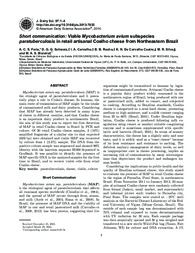Viable Mycobacterium avium subspecies paratuberculosis in retail artisanal coalho cheese from Northeastern Brazil.
Viable Mycobacterium avium subspecies paratuberculosis in retail artisanal coalho cheese from Northeastern Brazil.
Author(s): FARIA, A. C. S.; SCHWARZ, D. G. G.; CARVALHO, I. A.; ROCHA, B. B.; CASTRO, K. N. de C.; SILVA, M. R.; MOREIRA, M. A. S.
Summary: Mycobacterium avium ssp. paratuberculosis (MAP) is the etiologic agent of paratuberculosis and it potentially plays a role in Crohn’s disease. In humans, the main route of transmission of MAP might be the intake of contaminated milk and dairy products. Considering that MAP has already been detected in many types of cheese in different counties, and that Coalho cheese is an important dairy product in northeastern Brazil, the aim of this study was to report the first detection of MAP in retail Coalho cheese in Brazil by PCR and culture. Of 30 retail Coalho cheese samples, 3 (10%) amplified fragments of a similar size to that expected (626 bp) were obtained and viable MAP was recovered by culture from 1 (3.3%) sample. The DNA from the positive culture sample was sequenced and showed 99% identity with the insertion sequence IS900 deposited in GenBank. It was possible to identify the presence of MAP-specific DNA in the analyzed samples for the first time in Brazil, and to recover viable cells from retail Coalho cheese.
Publication year: 2014
Types of publication: Journal article
Unit: Embrapa Dairy Cattle
Observation
Some of Embrapa's publications are published as ePub files. To read them, use or download one of the following free software options to your computer or mobile device. Android: Google Play Books; IOS: iBooks; Windows and Linux: Calibre.
Access other publications
Access the Agricultural Research Database (BDPA) to consult Embrapa's full library collection and records.
Visit Embrapa Bookstore to purchase books and other publications sold by Embrapa.

